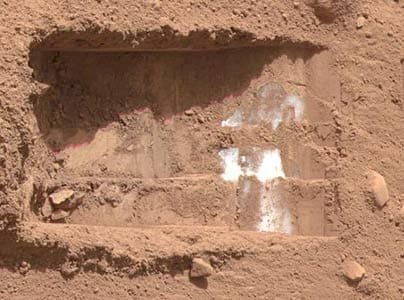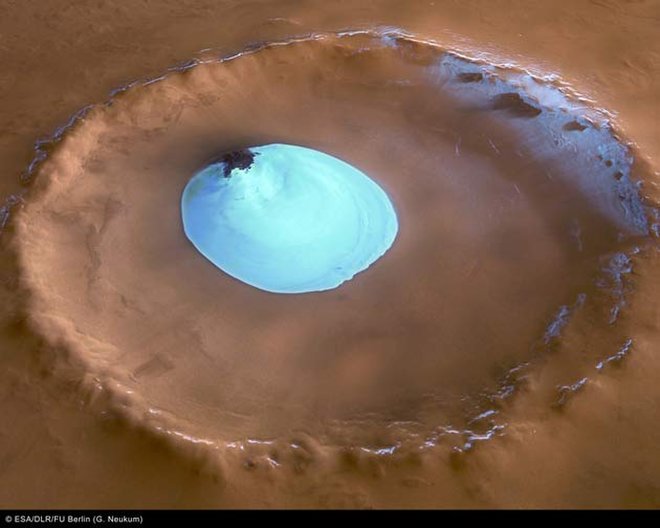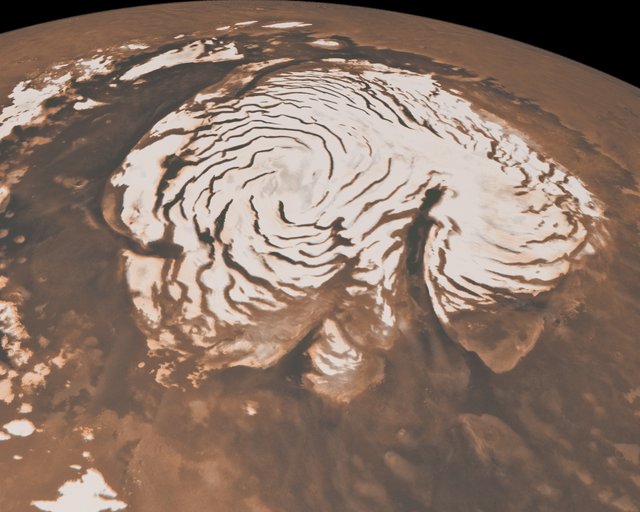Giant deposits of ice, discovered in the soil of Mars

The ice in the Martian soil can be an important water resource for future human crew missions.
Mars has many ice deposits outside polar zones, sometimes at depths of only 1 or 2 meters, which are precious potential water resources, easily accessible for future missions with astronaut crews, a study published Thursday in Science magazine.
This ice, which seems relatively "young", could also reveal the climate history of Mars, yet unlearned, AFP informs.
Scientists have identified eight areas where the erosion phenomenon has exposed large amounts of ice near the surface of the planet on the slopes. The study is based on data collected by the Mars Reconnaissance Orbiter (MRO), a space probe launched by NASA in 2005.

The existence of the ice in the Martian soil has been known for a long time, but many questions continue to exist about its thickness, its surface and its purity, the American researchers have explained.
Martian poles are covered with ice, and the MRO probe, located on the planet's orbit, has detected the presence of ice deposits of consistent thickness, buried almost all over Mars. That discovery was the subject of a study published in the journal Science in 2010.
The scientists then launched the hypothesis that they were the remains of glaciers that existed millions of years ago, when Mars's axis of rotation and planet's orbit were different.

Recent ice
The degree of fracture and steep angles indicate that the ice is compact and solid, American researchers said.
In addition, the color variations in these deposits make it clear that ice has been formed into distinct layers, which could help scientists better understand the climate change in the history of Mars.
These layers have probably formed from snow accumulations along numerous seasons in the previous climate cycles of the planet, said Susan Conway, professor of geology at Nantes University in France, quoted in an article published Thursday in the journal Science.
The low number of surface craters present in the eight areas indicates, according to the study, that this ice has formed quite recently.
Ice is only visible where the superficial soil layer has disappeared, indicating that the ice layers at low depths in the martian bark are even more extensive than indicated in this study.

Ice-rich areas have been found all at the latitude of about 55 degrees North and South, which, during the long Martian winters, become very cold and unhealthy for the human bases that are dependent on solar energy.
great discovering, thanks for sharing this wonderful news @modemser
always i try to get what is cool out for my followers
Fascinating stuff. I predict that we will eventually ship Martian water back to Earth, put it in bottles and then sell it for a ludicrous price. I also predict that people will queue to buy it.
will they drink the water on earth?
I'm sure that they will.
This is awesome
h2o
It is a great message and great invention of science. Thanks for sharing..
thanks i will keep the good work
Hi, I found some acronyms/abbreviations in this post. This is how they expand:
cool
Mars has quite a lots of ice , too bad for the low gravity issue.
Any chance that you cover up Jupiter's satellites?
I was always into that part more than into the Mars.